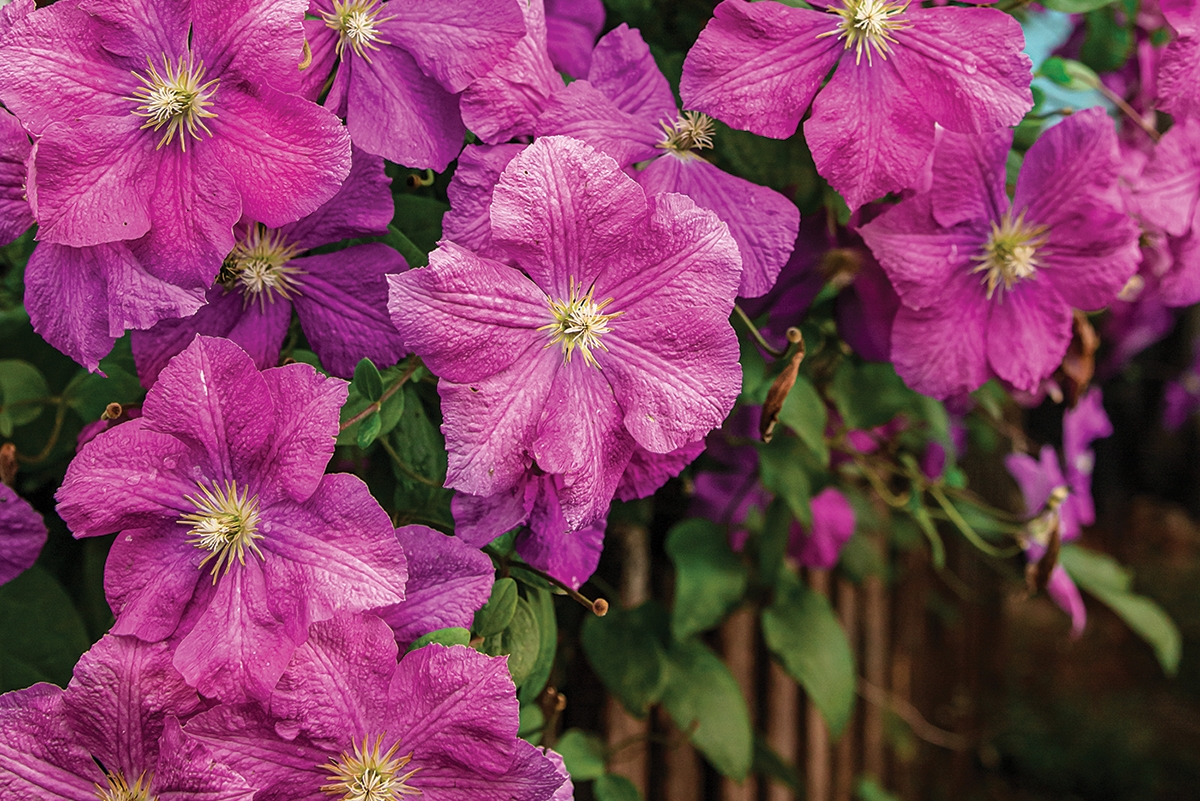Vertical Beauty
Vibrant Vines For Added Color, Interest, Privacy, Shade, And More

Vines add new dimension to landscapes by providing vertical interest and color. Choose vines by sunlight requirements and what type of structure they require for adequate support. Some vines, such as certain clematis, are light enough to scramble in, over, and around other plants. Other vines, such as wisteria, need strong support from sturdy arbors and trellises. Another important factor to consider is the method by which vines climb, as it can affect structures such as building siding and whether or not you need to help vines by tying them up.
So if you’re looking to add interest, increase privacy, hide unsightly views, or create shade in your landscape, following are some great vine options to consider. But first, it’s important to know that vines climb or grow in four ways:
– By twining their stems around vertical objects.
– By modified stems called tendrils which wrap around objects and sometimes have adhesive disks at their tips.
– By sprawling ... these are the plants that need to be tied to supporting structures since they have no mechanism by which to climb and stay attached.
– By clinging rootlets that grow along vine stems and attach to a support or wall. Vines that grow by clinging rootlets or that have adhesive disks, such as Boston ivy or climbing hydrangea, shouldn’t be planted on wood, stucco, or hardboard siding, and only on masonry structures, brick, or stone that is in good condition at the time of planting.
– Clematis: Twining. Fantastic displays of large, colorful blooms. A lightweight vine that can be grown on small trellises, mailboxes, and other plants. Plant in morning to midday sun and mulch over the root zone. To 6'-15'.
– Climbing Hydrangea: Clinging rootlets. A handsome and elegant vine with deep green, shiny, heart-shaped leaves, and lovely white lacecap flowers. Plant in part shade in moist, fertile soil.
– Climbing Roses: Sprawling. Many varieties available in a range of colors. Plant in sun in a rich, well-drained soil. Grow to 10'-25', depending on species or cultivar.
– Trumpet Honeysuckle (Lonicera sempervirens): Twining. The “good” honeysuckle (the one that won’t take over your garden and everyone else’s, unlike the Japanese form). Bright coral flowers from late spring to summer are visited by hummingbirds. Slow to moderate growth to 10' to 15'.
– Trumpet Vine (Campsis radicans): Twining and clinging rootlets. A boisterous plant both in growth (up to 40' or more) and in its flared cherry-pink and orange flowers which are produced in summer. Plant in sun to part shade where you have lots of room for a vine. Maybe grow it up an old tree for new beauty.
– American Wisteria (W. frutescens): Twining. Must be grown on very sturdy structures such as large arbors or well-anchored metal poles. Beautiful grape-like clusters of amethyst flowers have a delicate sweet scent. Plant in sun to part shade. Grows to 20' to 30'.
– Carolina Jessamine (Gelsemium sempervirens, also G. rankinii): Twining. Bright yellow trumpet flowers in spring. Plant in sun or shade (best flowering in sun). Fast growing to 20'. Plant with swamp jessamine (G. rankinii) for a bonus fall flower show.
– China Blue Sausage Vine (Holboellia coriacea): Twining. Weird name, cool vine! It features dark leathery leaves, silver-white bell-shaped flowers that have lovely fragrance, and blue sausage-shaped fruit. Plant in shade. Grows to 20'-30'.
– Evergreen Clematis: Twining. Abundant, fragrant white or pink flowers in spring over shiny green leaves. Plant so that the top of the plant will receive sun and the roots will be cool (mulch helps). Avoid afternoon sun. Excellent along fence tops or roof gables. Grows to 20'.
– Star/Confederate Jasmine: Twining. Profusions of fragrant, star-shaped flowers that bloom May through June and some in summer. Can be used as a groundcover. Plant in part sun to light shade. Grows 10'- 12', sometimes more.
– Cypress Vine (Ipomoea quamoclit): Annual. Twining. Fast growing vine with fine textured, feathery leaves and small, bright red flowers that hummingbirds love. Plant by seed in full sun in a well-drained soil of average moisture. Grows to 10'-15'.
– Mandevilla: Tropical (annual). Twining. Large, beautiful, trumpet-shaped red, white, and pink flowers are understandably popular. Plant in full sun in moderately moist soil or in a container. Grows to 10'.
– Camellia: What? That’s not a vine! No, no it isn’t. But, if you want an evergreen plant with stunning flowers that can be trained flat onto a trellis and only grows to about eight feet tall instead of 20 feet like many vines, then consider camellias for your space. Plant in part sun to light shade.
Tina Mast
Communications director at Homewood Nursery in Raleigh.
- info@homewoodnursery.com
- www.homewoodnursery.com
- 919-847-0117

